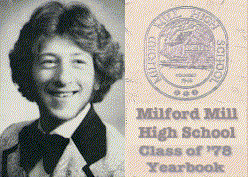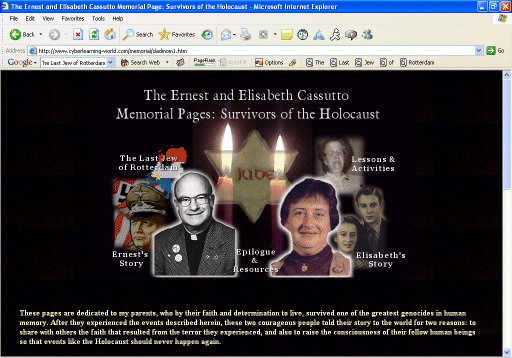The Graduate Manifesto of George Cassutto
The Evolution of My Education
 I have been a student in America's public schools since 1965, when I entered
Roosevelt Number 10 School in Passaic, New Jersey. I led an unremarkable
academic life after moving to Maryland where I graduated from Milford Mill High
School in 1978. I was an average student, but somewhere in my sixteenth year of
life, probably due to the combined influence of my parents and some brilliant
members of my peer group, I began to become interested in history, philosophy,
science, and religion. By the time I had entered Maryville College, a small,
liberal arts Presbyterian college nestled in the foothills of the Great Smokey
Mountains, I knew I was destined to teach History. The teacher education program
there opened my eyes to the fact that to get a job teaching History, you had to
be certified in Social Studies, which includes geography, psychology, sociology,
and political science. As these subjects are related, I had no problem expanding
my interests to cover these topics. In 1983, I landed my first teaching post in
Frederick County, Maryland.
I have been a student in America's public schools since 1965, when I entered
Roosevelt Number 10 School in Passaic, New Jersey. I led an unremarkable
academic life after moving to Maryland where I graduated from Milford Mill High
School in 1978. I was an average student, but somewhere in my sixteenth year of
life, probably due to the combined influence of my parents and some brilliant
members of my peer group, I began to become interested in history, philosophy,
science, and religion. By the time I had entered Maryville College, a small,
liberal arts Presbyterian college nestled in the foothills of the Great Smokey
Mountains, I knew I was destined to teach History. The teacher education program
there opened my eyes to the fact that to get a job teaching History, you had to
be certified in Social Studies, which includes geography, psychology, sociology,
and political science. As these subjects are related, I had no problem expanding
my interests to cover these topics. In 1983, I landed my first teaching post in
Frederick County, Maryland.
In the mid-1980s, there were few overriding trends in education that seemed
to characterize the profession even just a decade later. For the most part,
teaching involved lecturing, using the textbook, and assessing what students had
learned from those primary activities. Innovative teachers brought simulation,
debate, and primary document analysis into their classrooms. I became interested
in the clinical aspects of teaching and classroom behavior, and so I took a
position as education director of a group home, where students who were in the
juvenile justice system or who had been abused and neglected were brought into
the social services system. I became both administrator, teacher, and counselor,
bringing the in-board school of the group home up to state standards, monitoring
the progress of students who had transferred to the public school, and
intervening in crisis situations within the group home setting as they related
to school and education.
| The real education took place within my own style and approach to teaching. I
came to understand the challenges all young people face as they bring their
emotions and issues with them from their family constellations into the
homogeneity of the classroom. Eventually, I was able to take the clinical and
psychological skills that I had gained in the group home setting into the
regular classroom. It became apparent that relationship-building was a key
ingredient in being a successful teacher. I did not want to become a friend to
my students, but I wanted them to feel as though they could trust me and were
motivated to accomplish tasks I had asked them to complete. Establishing the
appropriate level of interest and self -disclosure is something that takes years
to calibrate, but once you feel comfortable with a level of closeness that maintains
professionalism, students will become more motivated, and the rewards for taking
the time to invest in your students pays well in emotional dividends. This
truth in knowing how to relate to young people would become valuable in
knowing how to establish a relationship of trust within the
mentor-student connection that is part of on-line learning. |
| It became apparent that relationship-building was a key
ingredient in being a successful teacher...
This truth in knowing
how to relate to young people would become valuable in knowing
how to establish a relationship of trust within the
mentor-student connection that is part of on-line learning. |
|
Beyond the feeling of connection and identification with students, I came to
realize how important it is for teachers to model for their students their love
of the subject matter which they teach. Within History and Political Science, I
came to develop certain themes that were important to me that I wanted to
communicate to my students. Since my parents were Holocaust survivors, one
important message that came to underlie most if not all of my lessons was that
of racial tolerance and understanding between ethnic groups and nationalities. I
grew up in the heyday of the Civil Rights Movement, and my father was a Jewish
Presbyterian minister. The moral lessons that were taught to me by my parents
and from the liberal media came through in my history and government classes.
Social Studies, for me, is the vessel by which I can legally communicate my
father's sermons and my mother's lessons (she later became a teacher of English,
French and German before she died of a brain tumor in 1984).
| The influence of my parents on
my choice of profession and on the life-themes that I would use as the
basis for my teaching was so great that once I had discovered the power
of the Internet to communicate on a mass scale, I created a web site
that told their story of survival and compassion. Based on my father's
book The
Last Jew of Rotterdam, I developed a web
site that included their story, lesson plan activities, and links to
Holocaust resources. It is one of the most-linked-to sections of my
present website by teachers, religious organizations, and non-profit
organizations interested in promoting acceptance and understanding
across racial and ethnic divides. |

The Cassutto Memorial Pages
|
 I
Stand Connected
I
Stand Connected
 I have been a student in America's public schools since 1965, when I entered
Roosevelt Number 10 School in Passaic, New Jersey. I led an unremarkable
academic life after moving to Maryland where I graduated from Milford Mill High
School in 1978. I was an average student, but somewhere in my sixteenth year of
life, probably due to the combined influence of my parents and some brilliant
members of my peer group, I began to become interested in history, philosophy,
science, and religion. By the time I had entered Maryville College, a small,
liberal arts Presbyterian college nestled in the foothills of the Great Smokey
Mountains, I knew I was destined to teach History. The teacher education program
there opened my eyes to the fact that to get a job teaching History, you had to
be certified in Social Studies, which includes geography, psychology, sociology,
and political science. As these subjects are related, I had no problem expanding
my interests to cover these topics. In 1983, I landed my first teaching post in
Frederick County, Maryland.
I have been a student in America's public schools since 1965, when I entered
Roosevelt Number 10 School in Passaic, New Jersey. I led an unremarkable
academic life after moving to Maryland where I graduated from Milford Mill High
School in 1978. I was an average student, but somewhere in my sixteenth year of
life, probably due to the combined influence of my parents and some brilliant
members of my peer group, I began to become interested in history, philosophy,
science, and religion. By the time I had entered Maryville College, a small,
liberal arts Presbyterian college nestled in the foothills of the Great Smokey
Mountains, I knew I was destined to teach History. The teacher education program
there opened my eyes to the fact that to get a job teaching History, you had to
be certified in Social Studies, which includes geography, psychology, sociology,
and political science. As these subjects are related, I had no problem expanding
my interests to cover these topics. In 1983, I landed my first teaching post in
Frederick County, Maryland.